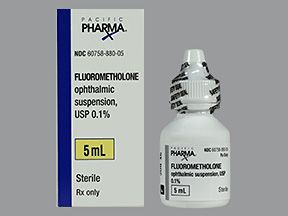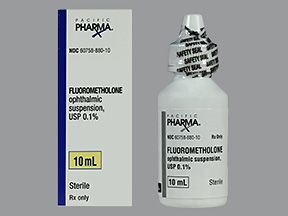- Fluorometholone is not available as a generic drug. It’s only available as brand-name drugs. Brand names: FML, FML Forte, and Flarex.
- This drug comes in the forms of eye drops (ophthalmic suspension) and an eye ointment (ophthalmic ointment).
- Fluorometholone is used to treat certain eye conditions caused by inflammation or injury.
- Eye effects: Using this drug long-term can raise your risk of increased pressure within your eyes. This can sometimes lead to glaucoma, cataracts, or vision problems. Your doctor may check your eye pressure while you take this drug.
- Infection: If you get an eye infection, fluorometholone may make this infection more severe or last longer.
Fluorometholone is a prescription drug. It comes as eye drops (ophthalmic suspension) and an eye ointment (ophthalmic ointment).
Fluorometholone isn’t available as a generic drug. It’s only available as the brand-name drugs FML, FML Forte, and Flarex.
Why it’s used
Fluorometholone is used to treat certain eye conditions caused by inflammation or injury.
How it works
Fluorometholone belongs to a class of drugs called ophthalmic corticosteroids. A class of drugs is a group of medications that work in a similar way. These drugs are often used to treat similar conditions.
It isn’t known exactly how fluorometholone works. It’s thought that this drug improves certain eye conditions by reducing inflammation.
Fluorometholone eye drops can cause side effects.
More common side effects
Some of the more common side effects of fluorometholone include:
- increased pressure in your eye
- allergic reactions
- feeling like you have something in your eye
- burning, stinging, or itchy eyes
- redness of your eyelid
- eye or eyelid swelling
- eye discharge
- increased tears
- skin rash
- changes in how foods taste
- eye pain
- blurry vision
If these effects are mild, they may go away within a few days or a couple of weeks. If they’re more severe or don’t go away, talk to your doctor or pharmacist.
Serious side effects
Call your doctor right away if you have serious side effects. Call 911 if your symptoms feel life-threatening or if you think you’re having a medical emergency. Serious side effects and their symptoms can include the following:
- Eye pain and inflammation. If this lasts longer than 48 hours or becomes worse, stop using this drug and call your doctor right away.
- Increased eye pressure. Using this drug long-term can lead to glaucoma, cataracts, and vision problems. Symptoms include:
- problems with vision
Disclaimer: Our goal is to provide you with the most relevant and current information. However, because drugs affect each person differently, we cannot guarantee that this information includes all possible side effects. This information is not a substitute for medical advice. Always discuss possible side effects with a healthcare provider who knows your medical history.
An interaction is when a substance changes the way a drug works. This can be harmful or prevent the drug from working well. To help prevent interactions, your doctor should manage all of your medications carefully. Be sure to tell your doctor about all medications, vitamins, or herbs you’re taking.
To find out how this drug might interact with something else you’re taking, talk to your doctor or pharmacist.
There are no known drug interactions with fluorometholone eye drops.
Disclaimer: Our goal is to provide you with the most relevant and current information. However, because drugs interact differently in each person, we cannot guarantee that this information includes all possible interactions. This information is not a substitute for medical advice. Always speak with your healthcare provider about possible interactions with all prescription drugs, vitamins, herbs and supplements, and over-the-counter drugs that you are taking.
This drug comes with several warnings.
Allergy warning
Fluorometholone can cause a severe allergic reaction. Symptoms can include:
- redness and swelling of your eyelid
- burning or itching of your eye
If you have an allergic reaction, call your doctor or local poison control center right away. If your symptoms are severe, call 911 or go to the nearest emergency room.
Don’t take this drug again if you’ve ever had an allergic reaction to it before. Taking it again could be fatal.
Warning for people with plans to have cataract surgery
Fluorometholone may delay your healing after cataract surgery.
For people with eye infections
Fluorometholone may mask the symptoms of certain eye infections. It may also make eye infections more severe. You shouldn’t use this drug if you have an eye infection.
Warning for pregnant women
Fluorometholone is a pregnancy category C drug. That means two things:
- Research in animals has shown adverse effects to the fetus when the mother takes the drug.
- There haven’t been enough studies done in humans to be certain how the drug might affect the fetus.
Talk to your doctor if you’re pregnant or planning to become pregnant. This drug should only be used if the potential benefit justifies the potential risk to the fetus.
Call your doctor if you become pregnant while taking this drug.
Warning for women who are breastfeeding
It is not known if fluorometholone passes into breast milk. If it does, it may cause side effects in a child who is breastfed.
Talk to your doctor if you breastfeed your baby. You may need to decide whether to stop breastfeeding or stop taking this medication.
Warning for children
Fluorometholone hasn’t been studied and shouldn’t be used in children younger than 2 years of age. The brand Flarex hasn’t been studied in children younger than 18 years of age.
All possible dosages and drug forms may not be included here. Your dosage, drug form, and how often you take the drug will depend on:
- your age
- the condition being treated
- how severe your condition is
- other medical conditions you have
- how you react to the first dose
Drug forms and strengths
Brand: FML
- Form: ophthalmic suspension
- Strength: 0.1%
Brand: FML Forte
- Form: ophthalmic suspension
- Strength: 0.25%
Brand: Flarex
- Form: ophthalmic suspension
- Strength: 0.1%
Dosage for inflammation or injury of the eye
Adult dosage (ages 18 years and older)
- The recommended dosage is one drop into the inside of your eyelids (conjunctival sac) two to four times per day. After 24–48 hours, your doctor may increase your dosage to one drop every 4 hours.
- For the brand Flarex, the recommended dosage is one to two drops into your conjunctival sac four times per day. After 24–48 hours, your doctor may increase your dosage to 2 drops every 2 hours.
Child dosage (ages 2 to 17 years)
- The recommended dosage is one drop into the inside of your child’s eyelids (conjunctival sac) two to four times per day. After 24–48 hours, your doctor may increase your child’s dosage to one drop every 4 hours.
- The brand Flarex hasn’t been studied in children.
Special dosage considerations
If you use fluorometholone for a long period of time and will be stopping its use, your doctor may slowly reduce your dosage of this medication. This is done to reduce your risk of having a flare-up of your eye condition.
Disclaimer: Our goal is to provide you with the most relevant and current information. However, because drugs affect each person differently, we cannot guarantee that this list includes all possible dosages. This information is not a substitute for medical advice. Always to speak with your doctor or pharmacist about dosages that are right for you.
Fluorometholone is typically used for short-term treatment. It comes with serious risks if you don’t take it as prescribed.
If you stop using the drug or don’t use it at all: If you don’t use fluorometholone, your eye pain and inflammation won’t improve and may get worse.
If you miss doses or don’t use the drug on schedule: Your medication may not work as well or may stop working completely. For this drug to work well, a certain amount needs to be in your eye at all times.
If you use too much: You could have dangerous levels of this drug in your eye. This could increase the pressure in your eye and lead to vision loss, cataracts, or glaucoma.
If you think you’ve used too much of the drug, act right away. Call your doctor or local poison control center, or go to the nearest emergency room.
What to do if you miss a dose: Administer your dose as soon as you remember. But if you remember just a few hours before your next scheduled dose, administer only one dose. Never try to catch up by administering two doses at once. This could result in dangerous side effects.
How to tell if the drug is working: You should have less pain and inflammation in your eye.
Keep these considerations in mind if your doctor prescribes fluorometholone for you.
Storage
- Store fluorometholone eye drops at room temperature or in the refrigerator. Keep them at a temperature between 36°F to 77°F (2°C to 25°C).
- Don’t store this medication in moist or damp areas, such as bathrooms.
Refills
A prescription for this medication is refillable. You should not need a new prescription for this medication to be refilled. Your doctor will write the number of refills authorized on your prescription.
Travel
When traveling with your medication:
- Always carry your medication with you. When flying, never put it into a checked bag. Keep it in your carry-on bag.
- Don’t worry about airport X-ray machines. They won’t damage your medication.
- You may need to show airport staff the pharmacy label for your medication. Always carry the original prescription-labeled box with you.
- Don’t put this medication in your car’s glove compartment or leave it in the car. Be sure to avoid doing this when the weather is very hot or very cold.
Self-management
- Your doctor, nurse, or pharmacist will show you how to give yourself the eye drops.
- Make sure you shake the eye drops well before using them.
- If you wear soft contact lenses, wait at least 15 minutes after administering fluorometholone into your eye before inserting your contact lenses. Fluorometholone eye drops contain a preservative (benzalkonium chloride) that may be absorbed by soft contact lenses.
Clinical monitoring
You may have your inner eye pressure monitored if you use this drug long-term. This is to check that your eye pressure stays in a normal range.
This monitoring may be done using a tonometry test, which measures the pressure inside your eye.
There are other drugs available to treat your condition. Some may be better suited for you than others. Talk to your doctor about other drug options that may work for you.
Disclaimer: Healthline has made every effort to make certain that all information is factually correct, comprehensive, and up-to-date. However, this article should not be used as a substitute for the knowledge and expertise of a licensed healthcare professional. You should always consult your doctor or other healthcare professional before taking any medication. The drug information contained herein is subject to change and is not intended to cover all possible uses, directions, precautions, warnings, drug interactions, allergic reactions, or adverse effects. The absence of warnings or other information for a given drug does not indicate that the drug or drug combination is safe, effective, or appropriate for all patients or all specific uses.


